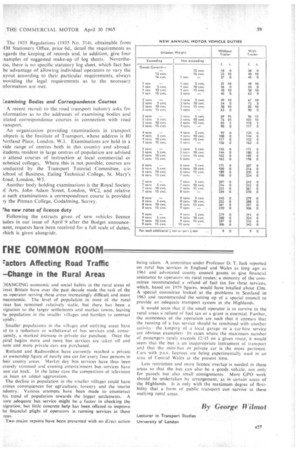rHE COMMON ROOM
Page 61

If you've noticed an error in this article please click here to report it so we can fix it.
=actors Affecting Road Traffic —Change in the Rural Areas
;HANGING economic and social habits in the rural areas of 'neat Britain have over the past decade made the task of the us operator serving these areas increasingly difficult and more ineconornic. The level of population in most of the rural reas has remained relatively static, but there has been a tigration to the larger settlements and market towns, leaving he population in the smaller villages and hamlets to contract a pidl y.
Smaller populations in the villages and outlying areas have .tcl to a reduction or withdrawal of bus services and, conseuently, a marked increase in private car purchase. Once the piral begins more and more bus services are taken off and nore and more private can are purchased.
Rutland and Radnorshire have currently reached a private ar ownership figure of nearly one car for every four persons in heir county areas. Market day bus services have thus been everely trimmed and evening entertainment bus services have een cut back. In the latter case the competition of television as been an added aggravation.
The decline in population in the smaller villages could have crious consequences for agr:culture, forestry and the tourist ndustry. Various attempts have been made to counteract his trend of population towards the bigger settlements. A lore adequate bus service might be a factor in checking the ligration, but little concrete help has been offered to improve he financial plight of operators :n running services in these reas.
Two major reports have been presented with no direct action
being taken. A committee under Professor D. T. Jack reported on rural bus services in England and Wales as long ago as 1961 and advocated county council grants to give financial assistance to operators on rural routes: a minority of the committee recommended a refund of fuel tax for these services, which, based on 1959 figures. would have totalled about £3m. A special committee looked at the problems in Scotland in 1963 and recommended the setting up of a special council to provide an adequate transport system in the Highlands.
It would seem that if the small operator is to survive in the rural areas a refund of fuel tax or a grant is essential. Further, the economics of the operation are such that it annears that the running of a bus service should be combined with another activity—the keeping of a local garage or a car-hire service are obvious examples? In cases where the maximum number of passengers rarely exceeds 12-15 on a given route, it would seem that the bus is an inappropriate instrument of transport and that the mini-bus or private car is the more pertinent. Cars with p.s.v. licences are being experimentally used in an area of Central Wales at the present time.
Less restriction and more licence overlap is needed in these areas so that the bus can also be a goods vehicle, not only for parcels but also small consignments. More GPO work should be undertaken by arrangement, as in certain areas of the Highlands. It is only with the maximum degree of flexibility that a .form of public transport can survive in these outlying rural areas.
By George Wilmot Lecturer in Transport Studies University of London




































































































